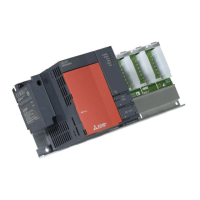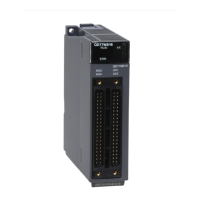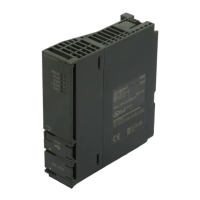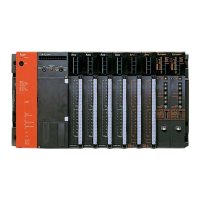7 - 6 7 - 6
MELSEC-Q
7 APPLICATION FUNCTIONS
7.2 Inter-Link Data Transfer Function (High Performance model QCPU, Process CPU,
Redundant CPU, and Universal model QCPU)
This function transfers link data to different networks in a batch mode using parameters
when multiple networks are connected to one programmable controller.
Interlink transfer is executable between CC-Link IE Controller Network, CC-Link IE
Field Network and MELSECNET/H.
POINT
Only one network module can be accepted on the Basic model QCPU,
Q00UJCPU, Q00UCPU, Q01UCPU, and safety CPU.
Hence, the inter-link data transfer function cannot be used.
(1) Inter-link data transfer function
(a) By using this function, it becomes unnecessary to transfer data between
networks with the sequence programs using the MOV instruction, etc.
(b) It is necessary to set the "Interlink transmission parameters" in order to
execute the inter-link data transfer function.
(c) The devices whose data can be transferred by the inter-link data transfer
are the link relay (LB) and link register (LW) of each network module (data
link module). The data of the link input (LX) and link output (LY) devices
cannot be transferred between data links.
(d) When sending data, set the device range within the host's send range of the
transfer from network module.
(e) When sending one batch of data to multiple networks, the same numbers
can be set for the device range of the transfer source. For example, when
transferring the data received from network number 1 (module 1) to both
network number 2 (module 2) and number 3 (module 3), the same transfer
from device range can be set for the interlink transmission parameters,
"Module 1
2" and "Module 1 3."
The figure below shows an example of transfer between network number 1 and
network number 2.
Set the "Interlink transmission parameters" for the programmable controller that
serves as the relay station.
In this example, the data of B0, which was turned on by station's 1M
P1 of network
number 1, is received by relay station 1N
S3 of network number 1. Then, the data
is transferred to the range (LB1000) assigned for relay station 2M
P1 of network
number 2.
Stations 2N
S2 and 2NS3 of network number 2 can thus check the on/off status of
B0 of station 1M
P1 of network number 1 through the data of B1000.
Network No. 1
1M
P1
1N
S22NS22NS3
Network No. 2
B0
B200
B1300
B1000
B200 B1000
B1300
B0
B280
B281
The transfer to
device of the
intermediate
station does not
turn on/off.
0
3FF
100
200
0
21F
1000
13FF
1FFF
2NS2
2N
S3
1000
101F
1300
1020
103F
B
Q25HCPU
LB
1N
S3
LB
2M
P1
1F
11F
1M
P
1
1N
S
2
131F
13FF
2M
P
1
(host)
to
to
1NS3
(host)
to
to
to
to
to
to

